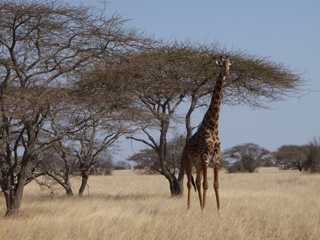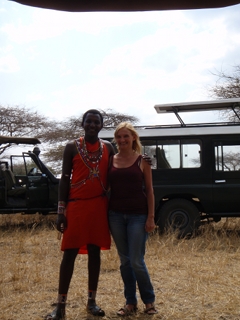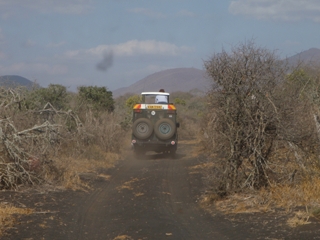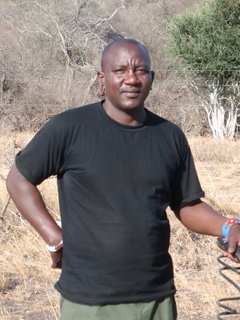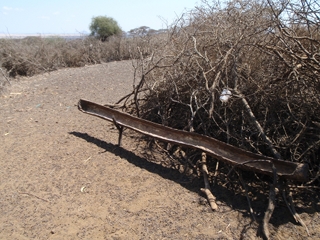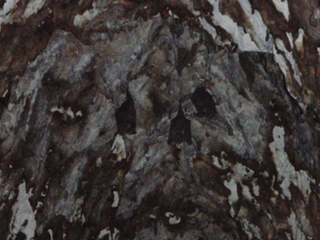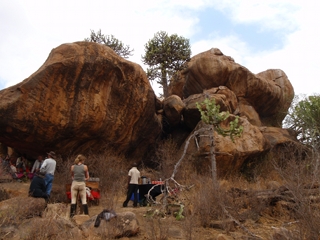 |
August 25
On the next day we broke camp again and started with hiking up large hills.
But, I received a complement at breakfast. Patrick looked at me and said
"You look clean!" Ha!! :)
The picture on my left is of Dori and Lorelei. They were friends from a
long time ago, then had drifted apart for something like 15 years, and now get
together once a year to go on a riding trip. Last year was Spain. This year,
Kenya. Next year??? I suggested Chile. :) Anyway, this picture gives you a
sense of the height of the hill (mountain?) we had climbed.
The fun thing about climbing over some of these hills was one part where
we were scrambling down a hill, and there was a very steep area from the
hill onto a road cut into the side of the hill that we ended up following
for a while. Patrick's comment? "This piece might be a bit technical."
Reality? It was a very steep incline!
|
|
There was one disaster this day. While we were stopped at one point for
people to remove some layers of clothing, Dori's horse startled a bit, and
Dori fell ... again. My memory is ok her laying on the ground, on her back,
and that her first word was "Ow." This fall, however, was not so bad and,
between that and the drugs she was on (ibuprofin seemed to be the drug of
choice around camp!), she was able to get back on and finish the day.
Somewhere around noon (meaning somewhere between 11:30 and 2:30, since lunch
time always varied!), we stopped for lunch under a flame tree. The picture
below shows our lunch spread, where we also laid down for a short nap / siesta
after lunch. Where I was sitting, I could look up at the flowers on the flame
tree, and watch something like a hummingbird get nectar from them. The picture
to the right is Dori, just because I liked the shot. :)
|
 |

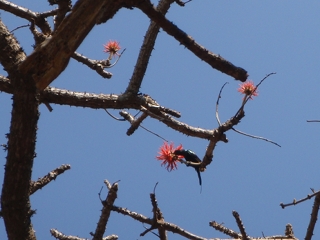
|
|
While we were here, a couple of Massia children who were tending a herd of
goats came by to watch. Below you can see them first approaching. While
my pictures only show two of them, there were actually four. Note the size
of the spear that the oldest is carrying!! One of their dogs was missing
part of his ear, so we asked why it was missing. It turns out that it was
cut off so that they could recognize the dog as theirs. Dori's response?
"Or you could use a collar!"
A picture of the goat herd the children were tending is also below. While
Patrick and Kim were sleeping, the Spanish guy (Juan, who was there with his
two teenage daughters, none of whom spoke much English) went into the goat herd
to pat the goats, and might also have fed them something. He left and came
back to where we were resting, and a couple of goats started to follow him.
Then they stopped. The suddenly the entire herd started heading for us!!
Patrick and Kim woke up just before the goats reached us, thus resulting in
my great action shot of Kim (I LOVE this pic!!) shooing away goats with the
scarf he had been wearing Arab style to protect his face from sunburn (since
he had lost his hat).
|
 |


|


|
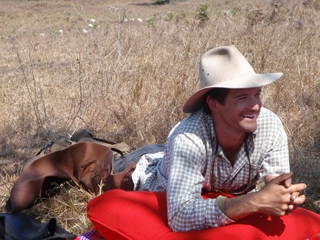
|
After the goat attack, everyone relaxed again, as you can see from the
smile on Patrick's face (on the left). Some folks went back to sleep, while
others stayed up. While we were staying up, another goat herd with three
Massai children came by. The children were very cute, being very curious
but still unsure about actually approaching us. The youngest (in the orange)
pretended to be nonchalant, while still trying to get our attention. Suzy
ended up going down and chatting with the kids for a bit. When she finished,
Lorelei and I ended up going down and chatting with them as well, and taking
pictures of them. The amazing thing (to me) is that these children spoke three
languages: Massai, Swahili and English.
|

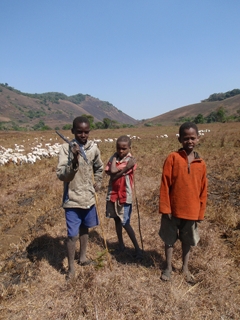

|
|
After the siesta, we took the jeep and drove about 15 minutes to the mist
forrest, where we ended up hiking for a bit. The mist forrest can now only
be found on the tops of the hills (and the one we hiked through was actually
very small - about 10 or 15 minutes to get from one side to the other using
a nice, well-worn, wide path). Apparently there is currently a theory (put
forth by a friend of Patrick's, who actually discovered three new species
while studying the mist forrest) that all of Kenya was covered by mist forrest
like you see below, but that they have been receding so that now they can only
be found in small pockets.
The middle picture below shows a strangler fig which has completely killed
the tree it was once climbing, leaving just the hollow now. I know that I've
seen strangler figs before, but for the life of me I can't remember where. I'm
thinking maybe Guatemala? Anyway, as we were hiking we suddenly heard branches
breaking in the woods to our right from some animal. Patrick automatically
ducked, swung, and pointed his rifle (did I mention that he never walks
anywhere without it?) into the woods. Meanwhile, Dori ducked behind me with
her hands on my arms, hiding! (I laughed afterward about my protecting her,
and she said that she could always push me towards the beast while she was
running away!) However, it turned out to be some type of gazelle only, and
that it was actually running away from us. In reality, that's probably a
good ending, but when writing it as a story it just sounds so lame!!
|

|



|

|
After the mist forrest, we returned to our lunch site to mount up and head
out again. On our way back we passed by some Kamba. Their houses were more
like grass huts, unlike the Massai houses made from mud. The Kamba are also
known to be more warrior-like and hunters, whereas the Massai raised livestock
instead. Every time we rode past some Kamba, we would wave and they would
wave back. As it turns out, the week before Patrick was riding through this
area and there were some children there who had never seen either a horse or
a white person before, so they got really scared and started crying!! We
passed some very cute kids, and there were some great photo ops, but
unfortunately I didn't have a chance to take any pictures.
The other fun thing about getting back to camp is that we ended up riding
in a bit, um, late. As in, the sun had set (around 6:30) but we arrived in
camp a little after 7pm. Because it is dangerous to be out after dark, we
ended up trotting along a road in single file, with Patrick in the front
snapping his elephant whip in order to frighten off anything in our path.
The road was incredibly dusty, so we (and the horses!) couldn't actually see
the road we were trotting along. In fact, we had to stay quite close to each
other just to see the butt of the horse in front of us so we knew where to
go! What's funny is that you hit a point where you are not worried about
how dangerous this is, but are just annoyed that you're not in front of the
fire with a drink yet!! And our tardiness obviously worried the staff, since
a jeep with a couple of the staff members met up with us since they decided
to come looking for us! Incredibly sweet, really.
|
|
While we were sitting around the camp fire, we heard an animal sounding like
it was dying. We listened for a few seconds, and it sounded like a buffalo.
As we listened, it sounded really familiar - it was the recording that Phillip
played to attract lions. And it sounded quite close. In fact, we were
wondering if it might have been an iPhone recording made by one of the Spanish
girls, and that she was playing it for their dad. We eventually realized that
no, it meant that Phillip was actually nearby. Phillip also learned that we
were nearby (one of the Massai told him), so he stopped by our camp. (The
pic on the right is Phillip, in case you couldn't guess!!)
It turns out that a lion had killed two donkeys in a Massai boma.
Traditionally what would happen after something like this is that the Massai
warriors would hunt down the lion and kill it; however, there is now a program
in Kenya where the villager will be reimbursed for his loss (always a "his"
loss - women are still generally property here) in return for not killing the
lion.
|

|
 |
Phillip was here with two Massai warriors - you can see both in the picture
below, albeit darkly, to the right of Phillip by the fire. In the picture on
the left, one of the warriors is looking for another lion (a female named
Birdie, who recently had a couple of cubs) using the radio tracking device I
had mentioned a couple of days ago. Both of the warriors are actually lion
killers. When the Massai go to kill a lion, typically eight warriors go on
the hunt. While all eight get some credit for the kill, the person who gets
the first spear in gets the most credit, the one with the second spear gets
a little less credit, and so on. Both warriors here had gotten the first
spear. The result is a lot of respect in their village, and their choice of
women (and a woman who is very proud to be his, given his bravery). Having
a lion killer now support the lions and track them lends legitimacy to not
killing the lions, while at the same time the warrior receives additional
prestige from having a job.
In this case the warriors had tracked two lions to about a mile away from
our camp (yikes!!), so Phillip had taken one of the dead (half-eaten) donkeys,
tied it to a tree, and called the lions using his recording. The lions that
were here are not collared, so they were tracked solely by the Massai. You
can see pics of them below - they are the two brothers who have formed a
coalition, again whom I had mentioned a couple of days ago. What was amazing
to me was how close we could get to them! We stayed in the jeep, but the
windows were down, and at the end we were probably only about ten feet or less
from the lion who was eating. You could hear him crunching on the bones of
the donkey! It was also interesting that we were there watching for a bit,
and the lions appeared concerned about something else they sensed off to the
left, and eventually left, followed by a couple of Massai coming up to the
jeep. The lions know they are not the top of the food chain, and so are very
wary of people! They had heard the two Massai and so left the area. The
Massai left after we chatted with them for a minute, and maybe ten minutes
later one of the lions (the smaller one) returned, while the other lion
remained in hiding the entire time we were there.
|


|


|
|
One last interesting tidbit about Massai. All males become warriors somewhere
between 15 and 18 years old. The ritual involves being circumcised without
any anaesthetic. After this, the Massai show their prowess as hunters. At
some point later (I'm unclear about when this transition occurs or why) the
warriors become elders, whose role it is to guide the direction of the tribe
(which apparently is just as political amongst the Massai as it is in any
Western culture!). And lest women think that only the men get to go through
such an initiation, the women also get circumcised, generally closer to age
13 or 14. At one point there was a (white) woman who was going to make it
her mission to end female circumcision. Apparently she was approached by
about 50 Massai women saying "don't mess with our culture", since they viewed
circumcision as a key component of becoming a woman.
|
|








